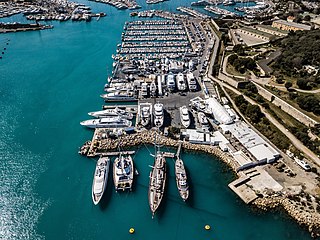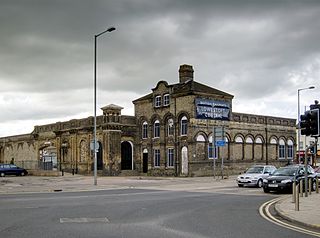
The River Waveney is a river which forms the boundary between Suffolk and Norfolk, England, for much of its length within The Broads. The "ey" part of the name means "river" thus the name is tautological.

Lowestoft is a coastal town and civil parish in the East Suffolk district of Suffolk, England. As the most easterly UK settlement, it is 110 miles (177 km) north-east of London, 38 miles (61 km) north-east of Ipswich and 22 miles (35 km) south-east of Norwich, and the main town in its district. The estimated population in the built-up area exceeds 70,000. Its development grew with the fishing industry and as a seaside resort with wide sandy beaches. As fishing declined, oil and gas exploitation in the North Sea in the 1960s took over. While these too have declined, Lowestoft is becoming a regional centre of the renewable energy industry.

The River Yare is a river in the English county of Norfolk. In its lower reaches it is one of the principal navigable waterways of The Broads and connects with the rest of the network.

A shipyard, also called a dockyard or boatyard, is a place where ships are built and repaired. These can be yachts, military vessels, cruise liners or other cargo or passenger ships. Compared to shipyards, which are sometimes more involved with original construction, dockyards are sometimes more linked with maintenance and basing activities. The terms are routinely used interchangeably, in part because the evolution of dockyards and shipyards has often caused them to change or merge roles.

Robert John Blizzard was a British Labour politician who served as member of Parliament (MP) for the Suffolk constituency of Waveney from 1997 until 2010.

Lowestoft railway station serves the town of Lowestoft, Suffolk. It is the eastern terminus of the East Suffolk Line from Ipswich and is one of two eastern termini of the Wherry Lines from Norwich. Lowestoft is 23 miles 41 chains (37.8 km) down the line from Norwich and 48 miles 75 chains (78.8 km) measured from Ipswich; it is the easternmost station on the National Rail network in the United Kingdom.
Lothingland is an area in the English counties of Suffolk and Norfolk on the North Sea coast. It is bound by the River Yare and Breydon Water to the north, the River Waveney to the west and Oulton Broad to the south, and includes the parts of Lowestoft north of Lake Lothing.

The Port of Cape Town is the port of the city of Cape Town, South Africa. It is situated in Table Bay.

Lake Lothing is a saltwater lake located in Lowestoft in the English county of Suffolk. The lake, which is believed to be the remnant of medieval peat cutting, flows into the North Sea and forms part of the Port of Lowestoft. The area was the major industrial centre of Lowestoft with ship building and other engineering industries, much of which has now closed.

Kirkley is an area of the town of Lowestoft in the East Suffolk district of the English county of Suffolk. It is located south of the centre of Lowestoft and the town's harbour and Lake Lothing. Kirkley was originally an independent village but is now part of the urban conurbation of Lowestoft. In 2011 the ward had a population of 7439.

The Port of Ramsgate is a harbour situated in Ramsgate, south-east England, serving cross-Channel freight traffic and smaller working and pleasure craft. It is owned and operated by Thanet District Council.
Brooke Marine was a Lowestoft-based shipbuilding firm. The company constructed boats and small ships for civilian and commercial use, as well as minor warships for the Royal Navy, Royal Navy of Oman, Royal Australian Navy, Kenya Navy and United States Navy.

The Port of Southampton is a passenger and cargo port in the central part of the south coast of England. The modern era in the history of the Port of Southampton began when the first dock was inaugurated in 1843. After the Port of Felixstowe, Southampton is the second largest container terminal in UK, with a handled traffic of 1.5 million twenty-foot equivalent units (TEU). It also handles cruise ships, roll-on roll-off, dry bulk, and liquid bulk.

Aberdeen Harbour, rebranded as the Port of Aberdeen in 2022, is a sea port located in the city of Aberdeen on the east coast of Scotland. The port was first established in 1136 and has been continually redeveloped over the centuries to provide a base for significant fishing and ship building industries. Since the 1970s it has provided support to the offshore oil and gas industry operating in the North Sea and it is the main commercial port in the north east of Scotland.

Mincarlo is the last surviving sidewinder fishing trawler of the Lowestoft fishing fleet. She is also the last surviving fishing vessel built in Lowestoft, with an engine made in the town.

The Port of Barrow refers to the enclosed dock system within the town of Barrow-in-Furness, England. Morecambe Bay is to the east of the port and the Irish Sea surrounds it to the south and west. The port is currently owned and operated by Associated British Ports Holdings, but some land is shared with BAE Systems Submarine Solutions. Currently consisting of four large docks, the Port of Barrow is one of North West England's most important ports. The docks are as follows: Buccleuch Dock, Cavendish Dock, Devonshire Dock and Ramsden Dock. The port of Barrow is the only deep water port between the Mersey and the Clyde.

Lowestoft Cemetery is a burial ground in the town of Lowestoft in Suffolk. It is best known for its large number of Royal Navy burials from World War I and World War II; these are maintained by the Commonwealth War Graves Commission. Thomas Crisp, who was posthumously awarded the Victoria Cross in 1917 is commemorated here on his wife's headstone. Buried here is Robert William Hook, coxswain at RNLI Lowestoft from 1853 to 1883 and who has been credited with saving more than 600 lives. The cemetery is managed by Waveney District Council.

Peterhead Bay is a large remote industrial tidal 120° facing coastal embayment, located next to the planned community, commercial fishing and ship building town of Peterhead in the Presbytery of Deer, Buchan, Aberdeenshire and is in the most easternmost point in mainland Scotland. The bay lies to the south of the town, forming a large natural harbour. It was enclosed by breakwaters, to turn the natural harbour into a marina and port, that is now owned by the Port of Peterhead. It was here, on 25 December 1715, that the old pretender, James Francis Edward Stuart, landed and resided at a house at the south end of Longate, owned by Mr James, and being visited by his friends, including George Keith, the Earl Marischal.

RV Platessa (LT205) was a fisheries research vessel that was operated by the Ministry of Agriculture, Fisheries and Food - Directorate of Fisheries, now known as the Centre for Environment, Fisheries and Aquaculture Science (Cefas) between 1946 and 1967.

Gull Wing Bridge is a road bridge being built to span Lake Lothing in the town of Lowestoft, Suffolk, England, which is claimed to be the largest rolling bascule bridge in the world lifted using hydraulic cylinders. The bridge is planned to be completed and open to traffic in early 2024.




















